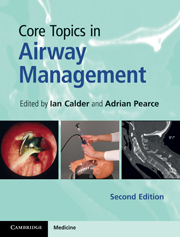Book contents
- Core Topics in Airway Management
- Core Topics in Airway Management
- Copyright page
- Contents
- Contributors
- Preface to the second edition – Calder and Pearce
- Section 1 Basic science
- Section 2 Clinical
- Chapter 6 Basic principles of airway management
- Chapter 7 Difficult airways: causation and identification
- Chapter 8 Obstructive sleep apnoea and anaesthesia
- Chapter 9 Facemasks and supraglottic airway devices
- Chapter 10 Tracheal tubes, tracheostomy tubes
- Chapter 11 Airway damage: iatrogenic and traumatic
- Chapter 12 Tracheal intubation: direct laryngoscopy
- Chapter 13 Tracheal intubation: flexible fibreoptic
- Chapter 14 Tracheal intubation: ‘blind’ methods
- Chapter 15 Tracheal intubation: rigid indirect laryngoscopy
- Chapter 16 Misplacement of tracheal tubes
- Chapter 17 Extubation
- Chapter 18 The aspiration problem
- Chapter 19 The lost airway
- Section 3 Specialties
- Section 4 Ethics and the law
- Section 5 Examination questions
- Index
Chapter 12 - Tracheal intubation: direct laryngoscopy
from Section 2 - Clinical
Published online by Cambridge University Press: 10 January 2011
- Core Topics in Airway Management
- Core Topics in Airway Management
- Copyright page
- Contents
- Contributors
- Preface to the second edition – Calder and Pearce
- Section 1 Basic science
- Section 2 Clinical
- Chapter 6 Basic principles of airway management
- Chapter 7 Difficult airways: causation and identification
- Chapter 8 Obstructive sleep apnoea and anaesthesia
- Chapter 9 Facemasks and supraglottic airway devices
- Chapter 10 Tracheal tubes, tracheostomy tubes
- Chapter 11 Airway damage: iatrogenic and traumatic
- Chapter 12 Tracheal intubation: direct laryngoscopy
- Chapter 13 Tracheal intubation: flexible fibreoptic
- Chapter 14 Tracheal intubation: ‘blind’ methods
- Chapter 15 Tracheal intubation: rigid indirect laryngoscopy
- Chapter 16 Misplacement of tracheal tubes
- Chapter 17 Extubation
- Chapter 18 The aspiration problem
- Chapter 19 The lost airway
- Section 3 Specialties
- Section 4 Ethics and the law
- Section 5 Examination questions
- Index
Summary
Keywords
- Type
- Chapter
- Information
- Core Topics in Airway Management , pp. 110 - 120Publisher: Cambridge University PressPrint publication year: 2010



